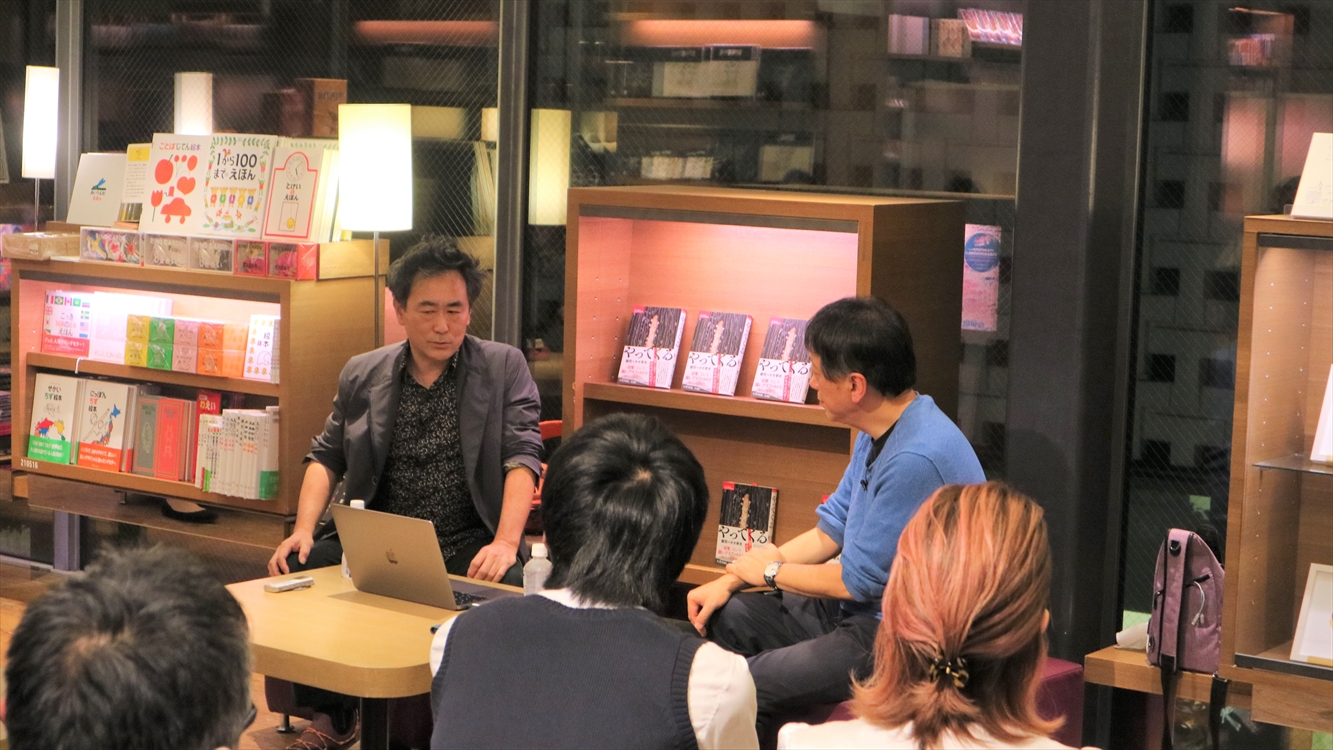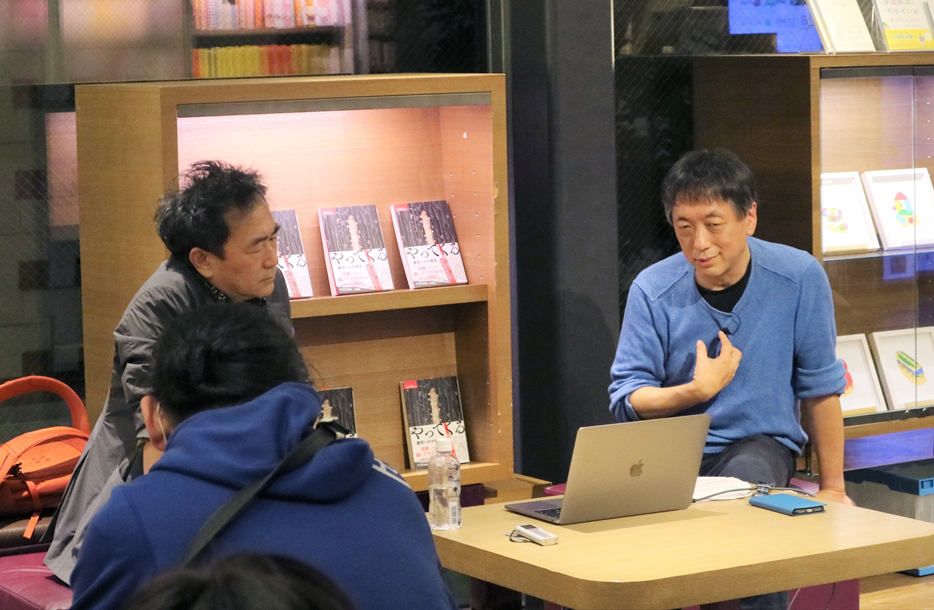[Event Report] Talk event between Pegio Gunji and Shinji Miyadai, "Towards a World of Uncoolness and Uncoolness" Transcription ③
~The consistent motif of "Yatsukuraru"~
Miyadai:Now, just in case there are people who haven't read "Yattekuru" or who could barely understand it, I'll give you a summary of what the story is about. At the beginning, something singing appears in a room where no one is supposed to be. This being is called "Mooller" because it sings "Mooller" (laughs). Why was this experienced? Just like Jung, it's not a question of whether UFOs exist or not, but of why UFOs were experienced. The answer is that the days spent worrying about the gap between the "signifier" and the "under-signified" invited something "coming" from outside.Next, it's a true story about someone who met someone on the street and asked "How are you?", and after talking for a few minutes, when they looked at his face, they turned out to be a stranger (lol). The previous story is also true, all of them are true. This also involves the under-signified that comes with meeting a strange friend, and the context of wanting to recognize "who this person is" is applied to this, creating a diagram in which something has "arrived" from the outside as a "friend."
Afterwards there is a discussion of deja vu. When you happen to be watching something and there is an unexpected turn of events that makes you go "huh?", a contradiction arises between two types of perfect tenses. The present perfect tense leading up to the "huh" moment and the present perfect tense after the "huh" moment become different. Normally, a rewrite would occur at this point, but for Gunji, no rewrite occurs, and the two perfect tenses exist side by side in a suspended state, so to speak. This suspended state calls for the movement to search for something that cannot be found, believing that it "must be there," which is experienced as nostalgia, resulting in deja vu.
Here, we are only looking at diagrams, so it is inevitable that qualia (quality of experience) does not arise, but reading it will convince you. By the way, qualia is the question of whether we are experiencing the same redness when Gunji and I look at the sunset and nod to each other, saying, "It's red," and "Yes, it's red." In fact, it is impossible to prove that we are experiencing the same redness. But "the same redness as him" "comes." In other words, everyone experiences it. That said, Gunji's experience was quite strange. The book writes that everyone should know about it, but many readers will think, "No, they didn't" (laughs).
The next part is about deciphering Gunji's experience of "the world freezing." The conclusion is explained by reversing the diagram above. The signifier and the signified are directly connected, so that what "comes" is erased and reality is lost. Although there is normally a gap between the signifier and the signified, for some reason they are directly connected, and as a result, nothing "comes" no matter what context is given. This is said to be a state in which reality is lost.
Next is a story about "Funk & Pop." Prince and Prince Akiyama Yutoku are featured. The two share a common element: the coexistence of uncool and uncool. This relates to the discussion of "and" and "or" in a later chapter, but when underdetermination occurs, something "arrives" from outside and becomes "new and amazing." It's the same as "Prosciutto and Melon." No matter how you look at it, it's hard to say whether prosciutto and melon taste good together. In fact, I think they don't taste good. And yet "Prosciutto and Melon" is served as a dish. So you eat it. Then an underdetermined state of "not knowing what it is" occurs. Then something comes from outside and becomes "new and delicious."
Next comes the topic of "authority." This is interesting. It can be linked to criticism of society today. When an underdetermined state is deliberately created by an order, a compulsive movement to fill the gap arises due to the frame problem. He writes that this is the essence of the "sontaku problem." A senior ramen shop owner tells you to make "pure ramen." This doesn't make sense. It's clearly underdetermined. This leads to a search for the signified of the authoritative order, but as it remains indetermined no matter how far you go, a movement of continued sontaku arises.
The last topic is "death." He calls something that can be seen with the eyes but you can't see beyond it, like the horizon, a frontier, and the dividing line between "up to the horizon" and "beyond the horizon" a boundary. "Death" is one or the other. You can experience the death of others, but not your own. Your own death is the same as the horizon. It's scary because you can't see what's beyond the horizon. So he talks about the invisible other side of religion. In order to understand where dead others go, he draws a boundary line that divides "the area where we do our work on this side of death" from "the area where God does his work on the other side of death." Death takes on the irreconcilable ambiguity of a horizon and a boundary line.
In this story, the frontier and the boundary are in conflict, but the certain moment that allows the person to accept the conflict as it is is the "rhinoceros beetle" that appears in Gunji's experiential episode. In the gap between the "or" of either a frontier or a boundary and the "and" of both a frontier and a boundary, an unspecified representation like "enlightenment" is given, and a passive voice that surrenders itself to the gap is born, and for the first time, one is able to accept one's own "death" -- it was a very moving story.
As I mentioned earlier, it is truly amazing how you can explain various dimensions, from the ordinary to the extraordinary, in the same consistent diagram. Now, from here on, I would like to ask Professor Gunji a few questions.
Gunji:First of all, I'm very grateful for such a wonderful summary. I try to write it in an easy-to-understand way, but I still get told things like "I have no idea what you're talking about," "You're self-righteous," and "That's just a normal mentality," which is always annoying. By the way, the catchphrase that runs through this whole thing is "lame and uncool." There, the self-reference that is too introspective and "uncool" and the frame problem that is too external and "lame" overlap, and if you think that just one of them is a problem, they cancel each other out, and something that is broken or not breaks up emerges. That's what "lame and uncool" means (laughs).
-Rather than prescribing the outside, hone your equipment to sense the outside-
Miyadai: Thank you (laughs). I have prepared some questions for you, hoping to ask about the things that many people will wonder about when they read your work. First of all, your recent works have a contemporaneous relationship with the various expressions around them. Similar activities are occurring simultaneously in many places. So, I was going to split my questions into two, but I'm going to put them together as one.
Since the mid-1990s, a movement known as the "ontological turn," as typified by the work of Dan Sperber and Bruno Latour, has emerged in anthropology, which has spread to philosophy, giving rise to various realist movements. There, various people such as Quentin Meillassoux and Markus Gabriel have slightly different arguments, but leaving aside the detailed differences in the arguments, we can see a landslide shift in social consciousness.
As seen in Niklas Luhmann's social system theory and Wittkenstein's language game theory, which influenced him, the sense that since we live in a society - since we live in a language game called society - it is natural to be closed off within it has become dominant since the mid-20th century. The obvious degraded version of this is the trend called constructivism. However, if it degrades too much, a backlash will arise. In fact, it did.
Since the 1990s, there has been a growing common sense that something outside of society -- I would call it the world -- definitely exists. Completely different from Kant's "thing in itself," Latour's concept of things (processed products) and Sperber's concept of representations (symbols) are "multiplications and mutations that use human activities as a culture medium, like a petri dish," and this dynamism directs us and tosses us around.
In other words, the outside is constantly "coming in." What we have "pretended not to see" is the work of civilization that has brought about the "inhumanity of anthropocentrism" -- the key point is that this is not limited to the work of modernity -- and it is this that has brought about today's inhuman nonsense that even foreshadows the "end of civilization." This is a crucial idea from anthropology, which has emerged to replace sociology, which ended its role in the early 1990s.
Shortly after the end of the Cold War in the 1990s, right-wing populism swept across Europe, and at the turn of the century it spread to America. Since the 1980s, sociology, including its criticism of democracy -- feminism, cultural studies, and postcolonial studies -- has pursued justice and fairness on the premise of the solidity of democracy, but this has turned into a bed of roses. In response to the emergence of the "deterioration of emotions" behind populism, political science has begun to propose deliberation, consensus conferences, facilitators, and second-order excellence.
But the problem was so big that the macro aspect had little meaning. As symbolized by the tragic decline of Boatland, Oregon, which became famous for its deliberative Neighborhood Association (NA) and was chosen by Setagaya Ward as a sister city, the city has survived as an anthropology of "posthumanist humanity," which questions the fact that we are closed off to words, laws, and profit and loss calculations because of our anthropocentrism.
This has also spread to AI research, with the so-called ontology problem (the universal proposition about what the world is like in the first place) as its hinge. In the last four or five years, for example, mathematical biologist Gunji Pegio Yukio's "Natural Intelligence" was published at the same time as mathematician Arai Noriko's "AI vs. Children Who Can't Read Textbooks," which was a surprising bestseller.
She also appeared on Marugeki Talk On Demand, where she said that the goal of Torobo-kun is to determine the limits of AI. When AI is made to solve entrance exam questions, it is clear that it can solve most multiple-choice questions, but it cannot solve essay questions for universities with a deviation score of 65 or higher, for example, because they are ontology problems. In fact, ontology problems are another name for the frame problem mentioned earlier.
"What is the world like in the first place?" As Gunji puts it, something "comes" into the gaps, and we feel that "the world is like this" regardless of empirical induction (Gunji's natural intelligence) or logical deduction (Gunji's artificial intelligence). However, because of the frame problem, AI would take an infinite amount of time to explore "what is the world like in the first place," and would not be able to solve entrance exam questions. Even if we make AI learn after the fact, "in this case, do this," or "in that case...," it is just a drop in the bucket.
From there onwards, the criticism is intense. We don't need people who can be replaced by AI and block chains. This is the same as the treatment of the machines that make up the minds of the government officials in Gunji's book Yattekuru, and there is criticism that humans can't really be that worthless. This is the same form as the criticism behind the Anthropological Renaissance that I mentioned earlier. This is what I call contemporaneity.
As another example, I'll talk about myself, if I may. As a film critic, I have been using the concept of "visiting from the world" for the past 20 years. This is almost the same as Gunji's concept of "coming." For the past 10 years, I have been using the word "scum." This refers to people who are trapped in conditional programs -- if-then statements -- and in Gunji's words, it refers to people who have been reduced to mere artificial intelligence. This is also contemporaneous.
Of course, a typical example of a conditional program is benefit calculations, or profit and loss calculations. This is nothing more than running a predetermined program over and over again. I have called this "trash." This spread of contemporaneity is not only seen in academic circles, but also in the film world. Kurosawa Kiyoshi is a typical example, who asks, "Look closely at the world we take for granted. It is not prescribed in the slightest. Many different things are happening. And yet you pretend not to see them?"
I know him well, and he has contributed writing to the theater pamphlet, so I'll talk a little about him. One day, a stranger appears, as you live your life pretending not to see him. That's what Gunji-san is like (laughs). Then, all of a sudden, the world you take for granted turns into ruins. The colors change and it becomes monochrome. It's a clear question: "Are you okay with being locked up like this?" This is also a contemporary expression.
There is a similar motif in the much talked about film "TENET" by Christopher Nolan. We live in forward time. If we put this ontological fact into parentheses, something might "come". If we could encounter people who live in reverse time as a thought experiment, how would the world that we take for granted as definable change? I'll leave that to my film review*, but in the film something "comes" and results in anthropological ethics.
* Shinji Miyadai's review of "TENET" (Part 1): Like "Memento," it is in the same lineage of "ontological turn"
https://realsound.jp/movie/2020/11/post-654252.html
*Shinji Miyadai's review of "TENET" (Part 2): Nolan is convinced by the mysterious and unfounded ethics
https://realsound.jp/movie/2020/11/65381.html
Because it uses a motif based on physics, there are plenty of physics-based points to criticize, and some people have actually done so (lol), but it's pointless. Rather, it's the same as Gunji's approach, and the essence of it is that if you create an undefined gap, something will "come." I also share Gunji's recognition that what "comes" there is "gospel" rather than a "source of anxiety." Here again, there is a contemporaneity.
Returning to Kurosawa Kiyoshi, I often write about horror film theory, and the tradition of Japanese horror, including his works, is that something mysterious that has been forgotten as we take it for granted suddenly "arrives," threatening our daily lives. However, his new film, "Wife of a Spy," depicts that "arrival" as gospel, and is a film that tells us to open ourselves up to new love and courage and to forge ahead.
There are countless other examples, including contemporaneity over the past 30 years and contemporaneity over the past five years or so, but putting that aside -- and stopping from asking questions that distinguish between the two -- can I first ask you whether you are aware of the various synchronizations that are occurring, and if so, why you think these synchronicities are occurring?
Since the mid-1990s, a movement known as the "ontological turn," as typified by the work of Dan Sperber and Bruno Latour, has emerged in anthropology, which has spread to philosophy, giving rise to various realist movements. There, various people such as Quentin Meillassoux and Markus Gabriel have slightly different arguments, but leaving aside the detailed differences in the arguments, we can see a landslide shift in social consciousness.
As seen in Niklas Luhmann's social system theory and Wittkenstein's language game theory, which influenced him, the sense that since we live in a society - since we live in a language game called society - it is natural to be closed off within it has become dominant since the mid-20th century. The obvious degraded version of this is the trend called constructivism. However, if it degrades too much, a backlash will arise. In fact, it did.
Since the 1990s, there has been a growing common sense that something outside of society -- I would call it the world -- definitely exists. Completely different from Kant's "thing in itself," Latour's concept of things (processed products) and Sperber's concept of representations (symbols) are "multiplications and mutations that use human activities as a culture medium, like a petri dish," and this dynamism directs us and tosses us around.
In other words, the outside is constantly "coming in." What we have "pretended not to see" is the work of civilization that has brought about the "inhumanity of anthropocentrism" -- the key point is that this is not limited to the work of modernity -- and it is this that has brought about today's inhuman nonsense that even foreshadows the "end of civilization." This is a crucial idea from anthropology, which has emerged to replace sociology, which ended its role in the early 1990s.
Shortly after the end of the Cold War in the 1990s, right-wing populism swept across Europe, and at the turn of the century it spread to America. Since the 1980s, sociology, including its criticism of democracy -- feminism, cultural studies, and postcolonial studies -- has pursued justice and fairness on the premise of the solidity of democracy, but this has turned into a bed of roses. In response to the emergence of the "deterioration of emotions" behind populism, political science has begun to propose deliberation, consensus conferences, facilitators, and second-order excellence.
But the problem was so big that the macro aspect had little meaning. As symbolized by the tragic decline of Boatland, Oregon, which became famous for its deliberative Neighborhood Association (NA) and was chosen by Setagaya Ward as a sister city, the city has survived as an anthropology of "posthumanist humanity," which questions the fact that we are closed off to words, laws, and profit and loss calculations because of our anthropocentrism.
This has also spread to AI research, with the so-called ontology problem (the universal proposition about what the world is like in the first place) as its hinge. In the last four or five years, for example, mathematical biologist Gunji Pegio Yukio's "Natural Intelligence" was published at the same time as mathematician Arai Noriko's "AI vs. Children Who Can't Read Textbooks," which was a surprising bestseller.
She also appeared on Marugeki Talk On Demand, where she said that the goal of Torobo-kun is to determine the limits of AI. When AI is made to solve entrance exam questions, it is clear that it can solve most multiple-choice questions, but it cannot solve essay questions for universities with a deviation score of 65 or higher, for example, because they are ontology problems. In fact, ontology problems are another name for the frame problem mentioned earlier.
"What is the world like in the first place?" As Gunji puts it, something "comes" into the gaps, and we feel that "the world is like this" regardless of empirical induction (Gunji's natural intelligence) or logical deduction (Gunji's artificial intelligence). However, because of the frame problem, AI would take an infinite amount of time to explore "what is the world like in the first place," and would not be able to solve entrance exam questions. Even if we make AI learn after the fact, "in this case, do this," or "in that case...," it is just a drop in the bucket.
From there onwards, the criticism is intense. We don't need people who can be replaced by AI and block chains. This is the same as the treatment of the machines that make up the minds of the government officials in Gunji's book Yattekuru, and there is criticism that humans can't really be that worthless. This is the same form as the criticism behind the Anthropological Renaissance that I mentioned earlier. This is what I call contemporaneity.
As another example, I'll talk about myself, if I may. As a film critic, I have been using the concept of "visiting from the world" for the past 20 years. This is almost the same as Gunji's concept of "coming." For the past 10 years, I have been using the word "scum." This refers to people who are trapped in conditional programs -- if-then statements -- and in Gunji's words, it refers to people who have been reduced to mere artificial intelligence. This is also contemporaneous.
Of course, a typical example of a conditional program is benefit calculations, or profit and loss calculations. This is nothing more than running a predetermined program over and over again. I have called this "trash." This spread of contemporaneity is not only seen in academic circles, but also in the film world. Kurosawa Kiyoshi is a typical example, who asks, "Look closely at the world we take for granted. It is not prescribed in the slightest. Many different things are happening. And yet you pretend not to see them?"
I know him well, and he has contributed writing to the theater pamphlet, so I'll talk a little about him. One day, a stranger appears, as you live your life pretending not to see him. That's what Gunji-san is like (laughs). Then, all of a sudden, the world you take for granted turns into ruins. The colors change and it becomes monochrome. It's a clear question: "Are you okay with being locked up like this?" This is also a contemporary expression.
There is a similar motif in the much talked about film "TENET" by Christopher Nolan. We live in forward time. If we put this ontological fact into parentheses, something might "come". If we could encounter people who live in reverse time as a thought experiment, how would the world that we take for granted as definable change? I'll leave that to my film review*, but in the film something "comes" and results in anthropological ethics.
* Shinji Miyadai's review of "TENET" (Part 1): Like "Memento," it is in the same lineage of "ontological turn"
https://realsound.jp/movie/2020/11/post-654252.html
*Shinji Miyadai's review of "TENET" (Part 2): Nolan is convinced by the mysterious and unfounded ethics
https://realsound.jp/movie/2020/11/65381.html
Because it uses a motif based on physics, there are plenty of physics-based points to criticize, and some people have actually done so (lol), but it's pointless. Rather, it's the same as Gunji's approach, and the essence of it is that if you create an undefined gap, something will "come." I also share Gunji's recognition that what "comes" there is "gospel" rather than a "source of anxiety." Here again, there is a contemporaneity.
Returning to Kurosawa Kiyoshi, I often write about horror film theory, and the tradition of Japanese horror, including his works, is that something mysterious that has been forgotten as we take it for granted suddenly "arrives," threatening our daily lives. However, his new film, "Wife of a Spy," depicts that "arrival" as gospel, and is a film that tells us to open ourselves up to new love and courage and to forge ahead.
There are countless other examples, including contemporaneity over the past 30 years and contemporaneity over the past five years or so, but putting that aside -- and stopping from asking questions that distinguish between the two -- can I first ask you whether you are aware of the various synchronizations that are occurring, and if so, why you think these synchronicities are occurring?

Gunji: I haven't seen "TENET" yet, but I'm interested. In fact, the model that was used around 1990 was a model in which motion is realized by the interference of a time-forward dynamical system in which time moves from the past to the future, and a time-reverse dynamical system in which time moves from the future to the past. It's such a bizarre idea that it's been completely ignored.
I myself am not very conscious of contemporaneity. My attitude hasn't changed at all since I was young, that is, in the late 1980s. I'm doing the same thing. For example, Bruno Latour published Actor-Network in 2005, which proposed the confusion of types (typological symbols) and tokens (symbols as concrete individual objects), and it's only recently that it has become an issue in Japan. The Japanese translation was released in 2019. But I started from John Barwise's Infomorphism (1999), which discusses the duality of types and tokens, in 2000, and have been conducting simulations that repeatedly distinguish and confuse types and tokens, using a mathematical model to dismantle the mathematical definition of the duality between the two. It was only in 2003 that it was published in English, so it is unrelated to Latour and independent. I discussed it a little in my Japanese book (Theory of Life I/II, 2002/2003), but no one even bothers to consider it an issue. You think you are connected to the outside world, but from their perspective you are isolated.
Barwise's infomorphism is an attempt to resolve the frame problem by formalizing the infinite chain of frames as a chain of type-token duality relations. This is the idea of overcoming the frame problem with artificial intelligence. My model was intended as a positive reversal of this, but since I am skeptical from the premise that the concept of type-token opposition exists, I think it is rather suggestive of how to confront AI. But now I'm not so interested in it anymore. If we don't find a better way, we will encourage confusion of type-tokens, and the "externality" that confusion summons will not be fully realized. This is one example, but for me, contemporaneity is not very beneficial. I feel that it will be too late unless we build a clearer way of interacting with the outside world.
I have always thought the same thing, but far from living in the same era, I was isolated. From the beginning, even though there may have been things that at first glance seemed to be common sense, a common human foundation, or the same creatures, we have no choice but to live by exploring the invisible other side, and that is the essence of living. I have thought so. I called it an internal observer, and have continued to think of a concrete example, or device, of living well with the outside world and inviting the outside world. At that time, my only theoretical companion was Professor Koichiro Matsuno, who first used the term internal observation. Whether it was asynchronous hierarchical self-reference, positive trauma, or "coming," I simply thought of the device that I thought was the best way to deal with the outside world each time.
So, even though we are from the same era, our motivations are different. I have had the conviction of an outside world that I cannot recognize from the beginning. So why is the outside world becoming an issue as a trend of the times? I think I can explain it, but it seems unreliable to me. I think the outside world has always existed, but as society and technology have advanced, people have become anxious about it and it has become apparent. But I worry about whether people are really aware of it.
For the philosopher Kant, the outside that needed to be explained was self-evident. Therefore, I think all that needed to be thought about was the development of a language to explain it. However, formalized and systematized language is fraught with the fallacy of thinking of the whole constructed by language as the world. After Kant, phenomenology emerged, which first assumed that the outside was self-evident, but questioned whether it is possible to directly touch the outside. It said that one can never touch raw reality, and that the reality in brackets is a phenomenon that is realized as a result of the interference between the outside and cognition. At first glance, this seems accurate, but it means that we are closed off to a perceptual world constructed from phenomena.
Husserl and Merleau-Ponty were probably motivated by something outside of phenomena, but the belief that "what we can perceive constitutes the world" is the basic principle of AI. In fact, Minsky conceived of artificial intelligence under the influence of Husserl, and autopoiesis and affordance derived from phenomenology are highly consistent with the basic principles of AI. This coincides with the beliefs of students majoring in modern science. When scholars of the humanities criticize science, they often counter-criticize by saying, "But physics explains reality to this extent, and makes reality to this extent comfortable. Can philosophy do that?" But that is the result of limiting the real world to only what we can measure and explain.
When this issue came up in a discussion, novelist Kazushi Hosaka said, "The people who invented the automobile were clever. At first, people wondered if the automobile was useful in this bumpy world. But they built roads everywhere, and turned the world upside down, saying that where there are roads, that is the world. So, of course, the automobile became useful in the world." Science has not explained reality, but has made what can be explained into reality. As a result, various things such as literary sensibility, sensitivity to heterogeneity, and thorough externality are excluded. The externality that Miyadai mentioned is excluded there.

Miyadai: Or it was something you didn't have to think about.
Gunji: That's right. Why is the outside ignored even when it is noticed? I think it is because we are initially satisfied with a closed world (for example, the perceptual world of phenomenology), and then when we feel some lack or anxiety, we repeatedly recognize that the outside is what is additionally required. From that perspective, we never arrive at the idea that the outside penetrates into the very foundations of the world, is inherent, and even forms the basis of it.
I think that the outside required by scarcity is, so to speak, a parenthetical outside - a pseudo-exterior - that pairs with the inside to form a new closed world. Because it is required by scarcity, it takes on a certain functionality and can form a relationship with the inside that complains of scarcity. Therefore, the pseudo-exterior that is additionally required is always destined to be incorporated into a closed world. Sensitivity to the outside, which is not a pseudo-exterior, is honed by those who are in contact with art, literature, and reality, but it may be difficult in academia.
The history from Kant to Husserl has been rehash as the history of systems theory. Kant, so to speak, privileges the theorist, and systems theory also initially privileges the design subject in the form of control. However, when we consider the control relationships between various elements in order to control, we come across the idea that there is nothing that can be privileged, because a network of control appears in which anything that controls something is controlled by something else. The components of a system are the result of a cycle of "controlling and being controlled," so everything is a changing virtuality, and a kind of phenomenological reduction is realized.
There is no distinction between what is passive and what is active because everything circulates. Autopoiesis, which leads to Varela and Luhmann, who believe there is no inside or outside, inevitably emerges as soon as one realizes the groundlessness of the controlling subject. However, the core of the argument there is that "even if one turns one's attention to the outside, which even controls the controlling subject, it does not expand endlessly and become uncontrollable, but rather, although it is vast, it is closed, and therefore becomes a theory."
Miyadai:Unfortunately, that is what systems theory is. I'll talk about this later, but systems theory is not theoretically viable because it cannot actually complete the concept of being "vast yet closed."
Gunji:The problem is whether it is really possible to reach the outside of a broad but closed theory - an outside that is not a pseudo-exterior. I sympathize with Gibson on affordances, but I am not very interested in subsequent affordances. Gibson himself considered the acceptance of affordances from the environment and the discomfort and contact felt there at the same time as the two wheels of his ecological psychology. The act of accepting what the environment shows us is, at the same time, a dialogue with a sparking heterogeneity. But this contact and affordance are not consistent. I thought the real problem was whether we could conceive of dynamic affordances in a way that thoroughly incorporates contact, but that is not the case. If we make it a pre-established, two-way loop of "we accept and adapt to what is afforded to us from the other side," it is very easy to understand, so affordances are completed with just this loop.
The discomfort in contact is not just the "I" that receives and the other (environment) that "I" imagines as affording, but should also be a device that takes on externality. I have the feeling that this point is ignored in affordance theory after Gibson. However, even if we assume that the place where we originally stand is "here" -- that is, the relationship between "I" and the environment that "I" imagines -- this is an arbitrary assumption, and it is finite and has limitations. Therefore, we will eventually hit a wall and become aware of what is on the other side of the limit, but such an awareness is not of the outside, but of a pseudo-outside.
As civilization and technology advance, not only does "I control myself," but even in the surroundings surrounding the self, which was the controlling subject, "generalized systemization," as Miyadai says, occurs. The situation in which the controlling subject is not privileged is something that should have been the case from the beginning, but we do not realize this until generalized systemization becomes a reality. This is also a very insensitive story. This is how autopoiesis and affordances emerged. What is there is not even an outside or pseudo-outside, but an inside and an outside. It is a system in which the outside enters the inside, is reconstructed, and responds to the outside. In 2019, Juan Leterrier, who inherits autopoiesis at the University of Chile, said that autopoiesis is not yet a completed theory, and that it is necessary to insert evolution and connections with the outside and develop it. What is called the outside is a pseudo-outside that is recognized as a shortage, and it is an outside that is destined to be incorporated into the inside.
The situation of being confronted with a pseudo-exterior that is destined to be internalized means, in other words, that one only recognizes what is convenient for oneself and will be useful (captureable) in the future. The basic concept of AI is a system that continues to transform itself while confronting a pseudo-exterior. This is connected to philosopher Andy Clark's "born cyborg," which expands the self while constantly incorporating interfaces (tools) with the outside world into itself, and the usefulness of the body as an interface here is deeply rooted in robotics and neuroscience, under the catchphrase "embodied mind." Here, the outside world is no longer something that one has to think about.
In response to this, I believe that Quentin Meillassoux's speculative realism and Markus Gabriel's new realism emerged by aiming for the outside of the phenomenological closed domain. It refers to the same outside as what I think of as "an outside that cannot be recognized but probably exists." If it were to be materialized, it would fall into a pseudo-exterior, so that is not possible. Since the outside cannot be recognized, what can be done by discussing the outside is to practice how to deal with the outside, how to summon the outside. This deviates from the way philosophy - philosophy as theory - is, which at least posits the outside, relates it to the known, and aims to theorize including the outside. However, if we do not do that, our world will simply remain trapped by the outside.
Miyadai: I agree with you on a number of points. First, what you said at the end. I think that arguments based on realism, whether naive or speculative - the position that we should live based on ontology - may end up becoming an extension of the same "new closure" scheme of being "closed off to the outside". In fact, rather than reading Meillassoux's speculative realism, it is more interesting to read Viveiros de Castro's anthropological description - a paper that describes how to understand the representation of animistic experience and union. The reason is that, as Mr. Gunji said, Meillassoux ended up just providing a "new closure".
To touch on the issue you mentioned earlier, it was social systems theorist Luhmann who developed Varela's neurophysiological system theory into a system theory that describes society. In the 1980s, he said that his work was radical constructivism, but that was the end of his luck (laughs). However, the books and papers he wrote in the 1960s clearly spoke of realist thinking.
First, let us assume that both the environment based on the consciousness system and the environment based on the social system are constructed by the system - that they exist in a system-related manner. However, humans die if they bathe in water over 60 degrees, and if they don't eat, so they die if the economy doesn't work, and they die in wars. Of course, if people die, society dies too.
Luhmann, aware of this, came up with a strange concept that would later become an issue in the Habermas vs. Luhmann debate. He said that the environment created by a system, whether it be a conscious system or a social system, is "predeterminable environmental complexity", but that this presupposes "irreducible environmental complexity". This was in The Functions of Formal Organization and Its Consequences (1969). Of course, "irreducible environmental complexity" meant "an environment that is not correlated with the system". When I was a graduate student in the early 1980s, I thought this was becoming an interesting story about the "impossibility of systems theory".
However, after that, he stopped discussing the relationship between "indefinable environmental complexity" and "definable environmental complexity." This was a major weakness of Luhmann that was pointed out in his debate with Habermas in 1970. As I mentioned earlier, constructivism has been all the rage in sociology since the 1980s, but it suffers from the same problem. It is impossible to construct everything, and something that is the premise for construction is "coming." In that sense, I can understand what Gunji said very well. If we are closed off to "what is coming," no matter how much we expand the outside, we will just be going around in circles doing the same thing. Confirming this was the greatest benefit of "Coming."
--Continued in No.4
Speakers:Pegio Yukio Gunji(Gunji)・ Shinji Miyadai(Miyadai)
Transcription: Makoto Wakaizumi (Miyadai Seminar)























